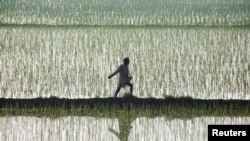Scientists warn that agriculture around the world can be significantly affected by climate change, and are now teaching farmers new technologies to adapt.
At one “climate smart” village in northern India, farmers are changing age-old practices to overcome the challenge of increasingly erratic weather patterns.
Harpreet Singh of Taraori village in northern Haryana state says recent years of failed rains and rising temperatures have damaged the paddy of wheat crop on his sprawling 30-hectare farm.
But unlike other farmers, this year’s weak monsoon rains did not worry him.
Singh has abandoned the age-old method of transplanting rice saplings after sprouting them in a nursery. Instead he planted “direct-seeded rice,” where seeds are sown and sprouted directly in the field.
New techniques
Singh smiles as he looks upon his lush rice crop, explaining the new laser-leveling technique that helps him conserve 25 to 30 percent more water. The high-tech approach to preparing soil reduces the need for irrigation by ensuring uniform distribution of moisture.
A prosperous farming region known as India’s bread basket, Haryana state is now home to 26 “climate smart villages,” all of which are part of an initiative led by the research consortium, Climate Change, Agriculture and Food Security (CCAFS) in India.
While India presently grows enough food to meet the needs of its 1.2 billion people, CCAFS scientists says erratic weather patterns, along with floods, drought, harsher summers and winters, could threaten national food security.
New Delhi-based agricultural economist Surabhi Mittal, who has been involved in the “climate smart project,” says teaching farmers how to become resilient in the face of climate change is crucial.
“The biggest impact on farmers is the declining yields and the increased losses, and their not being able to make an informed decision because the climate is so unpredictable that their conventional knowledge was failing,” she said.
Farmers agree. In Haryana's Anjanthali village, Vinod Kumar used to grow rice and wheat using traditional methods on his 10-hectare farm. But in recent years he says even village elders were puzzled by the new diseases attacking crops such as wheat, which scientists blame on increased temperature variation.
Kumar says new techniques have helped safeguard his crops and income, and even improved yields in some cases. Using crop residue to nourish his fields allows him to use less fertilizer, which is expensive and promoted soil depletion.
Fertilizer
Overuse of fertilizers is a common problem in India, not only ruining soil health, but also adding significantly to greenhouse gas emissions, and so farmers are being taught to use a tool called a “Nutrient Expert,” which helps them assess the amount of fertilizer they need to apply.
Another major initiative is to persuade farmers to diversify cropping patterns, encouraging farmers to grow maize instead of rice, particularly in areas subject to drastically decreased ground-water levels.
In Anjanthali, 34-year-old Vikas Chaudhury reels off the benefits, saying his maize crop is now ready for harvesting in 90 days instead of the 120 days required to cultivate rice. He says the switch also requires less water and gives him ample time to prepare his soil for the next crop.
But many farmers prefer not to switch from paddy to maize because they say growing rice is more profitable.
According to M.L. Jat, South Asia coordinator for the climate change project, falling water levels could make it difficult to sustain paddy cultivation.
“This is traditionally a rice area, so one farmer is growing rice and the other farmer is growing maize," he said. "Maize is very sensitive to water, so if that water comes to that area there is a problem. So you need to move as a community approach: if lots of farmers grow maize, so there is no fear, no risk.”
But he also emphasizes the need for entire communities to join the endeavor to cope with climate change in general.
While many scientists agree that change will occur slowly, even within the “climate smart villages” some farmers have not yet switched to the new techniques, as they wait to see how those who are adapting will fare.








